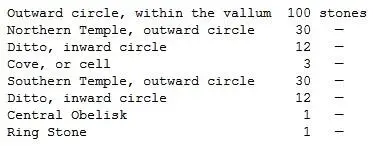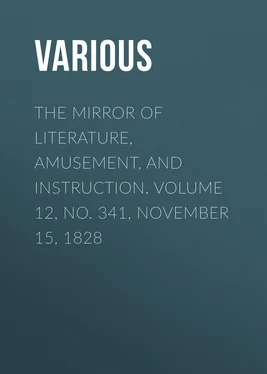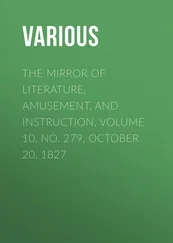Various - The Mirror of Literature, Amusement, and Instruction. Volume 12, No. 341, November 15, 1828
Здесь есть возможность читать онлайн «Various - The Mirror of Literature, Amusement, and Instruction. Volume 12, No. 341, November 15, 1828» — ознакомительный отрывок электронной книги совершенно бесплатно, а после прочтения отрывка купить полную версию. В некоторых случаях можно слушать аудио, скачать через торрент в формате fb2 и присутствует краткое содержание. Жанр: foreign_antique, periodic, Развлечения, foreign_edu, на английском языке. Описание произведения, (предисловие) а так же отзывы посетителей доступны на портале библиотеки ЛибКат.
- Название:The Mirror of Literature, Amusement, and Instruction. Volume 12, No. 341, November 15, 1828
- Автор:
- Жанр:
- Год:неизвестен
- ISBN:нет данных
- Рейтинг книги:3 / 5. Голосов: 1
-
Избранное:Добавить в избранное
- Отзывы:
-
Ваша оценка:
- 60
- 1
- 2
- 3
- 4
- 5
The Mirror of Literature, Amusement, and Instruction. Volume 12, No. 341, November 15, 1828: краткое содержание, описание и аннотация
Предлагаем к чтению аннотацию, описание, краткое содержание или предисловие (зависит от того, что написал сам автор книги «The Mirror of Literature, Amusement, and Instruction. Volume 12, No. 341, November 15, 1828»). Если вы не нашли необходимую информацию о книге — напишите в комментариях, мы постараемся отыскать её.
The Mirror of Literature, Amusement, and Instruction. Volume 12, No. 341, November 15, 1828 — читать онлайн ознакомительный отрывок
Ниже представлен текст книги, разбитый по страницам. Система сохранения места последней прочитанной страницы, позволяет с удобством читать онлайн бесплатно книгу «The Mirror of Literature, Amusement, and Instruction. Volume 12, No. 341, November 15, 1828», без необходимости каждый раз заново искать на чём Вы остановились. Поставьте закладку, и сможете в любой момент перейти на страницу, на которой закончили чтение.
Интервал:
Закладка:
Various
The Mirror of Literature, Amusement, and Instruction / Volume 12, No. 341, November 15, 1828
GRAND DRUIDICAL TEMPLE AT ABURY.
TEMPLE AT ABURY
Sermons in stones
And good in every thing.—SHAKSPEARE.
What means the mysterious circle of stocks and stones on the other side? Such will be the question of many a lover of fun, novel, fiction, and romance; and though we cannot settle their origin with the quickness or the humour of Munden's Cockletop , we will try to let our inquirer into the secret with the smallest show of mysticism possible.
Our engraving represents the Temple of Abury, the most extensive of all the ruins in Wiltshire, attributed to the Druids. Such was its original state, before the Vandalism of modern times destroyed and levelled much of its monumental grandeur. It consisted of a grand circle, containing two minor circles. The outer circle contained upwards of 28 acres, and was surrounded by a ditch. There was a circle within each of the two circles, contained within the circumvallation; and according to Dr. Stukely, the antiquarian, the original was thus composed:—

The Temple occupied a spot to which there is a gradual and imperceptible ascent on all sides, and was approached by two avenues of two hundred stones each. Its general form was that of a snake, in by gone ages, the symbol of eternity and omniscience. "To make the form still more elegant and picture-like, the head of the snake is carried up the southern promontory of Hack pen Hill—and the very name of the hill is derived from this circumstance." 1 1 Dr. Stukely, who says, that acan in the Chaldee signifies a serpent, and hac is no other than a snake. In Yorkshire they still call snakes hags ; and in the British language pen denotes a head.
The whole figure thus represented the circle, snake, and wings. By this the founders meant to picture out the nature of the Divinity; the circle meant the supreme fountain of all being, the Father; the serpent, that divine emanation from him, which was called the Son; the wings imported that other divine emanation from them, which was called the Spirit, the Anima Mundi . That the Temple was of a religious , and not of a warlike nature, is proved by its ditch being withinside the agger of earth, contrary to the mode adopted in works of defence.
Of the devastation and decay of Abury, the following data will afford some idea:
The grand total of stones, included in the temples and avenues, was 650; in the original temples, 188.

Of very late years, says Sir Richard Colt Hoare, I do not imagine the dilapidations of the temple have been very great.
It should, however, be mentioned, that the tracing of the snake form is due to Dr. Stukeley; for his predecessor Aubrey mentions the avenue as "a solemn walk leading to a monument upon the top of the hill, without any allusion to the supposed design or its connexion with the Grand Temple at Abury."
It is a matter of greater speculation than we can here enter into, as to the date and founders of Abury ; and their history is as dislocated as are the masses of its ruins. Antiquarians agree on the purpose for which it was founded, viz. for the performance of the religious ceremonies of the Druids. Sir R. Colt Hoare illustrates this point by supposing the flat ledge projecting from the vallum, to have been intended for the accommodation of sitting, to the spectators who resorted hither to the public festivals; and adds he, what a grand and imposing spectacle must so extensive and elevated an amphitheatre have presented, the vallum and its declivities lined with spectators, whilst the hallowed area was preserved for the officiating Druids, and perhaps the higher order of the people!
Gentle Reader! be ye lordling or lowlier born, once more turn back to the engraving . We have a subject of yesterday rife and ready for you, on the next page; but turn to the engraving . Look again at those circles, and the fantastic forms that compose them, and think of the infatuated thousands that were wont to assemble round them, and of the idolized sons of power that once stood within their hallowed area. Think of those days of sacrifice and superstition—those orgies of ignorance and barbarism—and contrast them with the happy, happy age of religious liberty in which it is your boast and blessing to live—and then you may read "sermons in stones," to the masterminds of your own time. To us, the stones of Abury are part of the poetry of savage life, and of more interest than all the plaster toys of these days. But they may not be so with you and "FINIS." We were once compensated for missing Fonthill and its finery, by witnessing day-break from Salisbury Plain, and associating its glories with the time-worn relics of STONEHENGE!
The engraving and data are from Mr. Higgins's Celtic Druids, for the loan of which and a portion of this article, we thank our friend "JAMES SILVESTER," whose valuable note on " Circular Temples " must stand over for our next.
We had penciled for our Supplement the following beautiful lines from Mr. Watts's "Literary Souvenir," but they will be more in place here. Silbury is an immense mound adjoining the road to Devizes, and opposite Abury; Sir R.C. Hoare thinks it part of Abury; but H. and many others think it the sepulchre of a King or Arch-Druid.
SILBURY HILL
Grave of Cunedha, were it vain to call
For one wild lay of all that buried lie
Beneath thy giant mound? From Tara's hall
Faint warblings yet are heard, faint echoes die
Among the Hebrides: the ghost that sung
In Ossian's ear, yet wails in feeble cry
On Morvern: but the harmonies that rung
Around the grove and cromlech, never more
Shall visit earth: for ages have unstrung
The Druid's harp, and shrouded all his lore,
Where under the world's ruin sleep in gloom
The secrets of the flood,—the letter'd store,
Which Seth's memorial pillars from the doom
Preserved not, when the sleep was Nature's tomb.
FINE ARTS
"The way to be an excellent painter is to be an
excellent man—and these united, make a character
that would shine even in a better world
than this."—JONATHAN RICHARDSON.
The sister arts of Painting and Engraving have been making great progress in England for some time past, and we are disposed to think this a subject of congratulation and importance to all classes of the community.
The literature of the Fine Arts is likewise becoming more and more popular every day. They form a prominent feature in every new literary project, and not unfrequently literature, to use a hackneyed phrase, is made their vehicle—like the namby-pamby of an English opera for the strains of Rossini or Weber. The public are contented with excellence in one department and mediocrity in the other; they cannot be constantly admiring—that is out of the question—and it is probably on this account that much of what appears below par is tolerated and even encouraged.
We will not go the length of assenting to the proposal of converting Sir Joshua Reynolds's Lectures into Sermons, by the mere alteration of the terms of art into scriptural phraseology; but we venture to assert that much national good is likely to result from these advances of art, and its constant introduction into all our amusements. That it promotes the growth of virtue is too old an axiom to be refuted:
Читать дальшеИнтервал:
Закладка:
Похожие книги на «The Mirror of Literature, Amusement, and Instruction. Volume 12, No. 341, November 15, 1828»
Представляем Вашему вниманию похожие книги на «The Mirror of Literature, Amusement, and Instruction. Volume 12, No. 341, November 15, 1828» списком для выбора. Мы отобрали схожую по названию и смыслу литературу в надежде предоставить читателям больше вариантов отыскать новые, интересные, ещё непрочитанные произведения.
Обсуждение, отзывы о книге «The Mirror of Literature, Amusement, and Instruction. Volume 12, No. 341, November 15, 1828» и просто собственные мнения читателей. Оставьте ваши комментарии, напишите, что Вы думаете о произведении, его смысле или главных героях. Укажите что конкретно понравилось, а что нет, и почему Вы так считаете.












